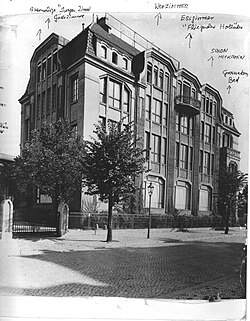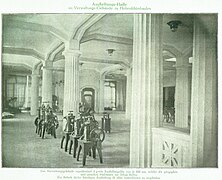Villa Heike
| Villa Heike | |
|---|---|
 View of the Villa Heike around 1911 |
|
| Data | |
| place | Berlin-Alt-Hohenschönhausen |
| architect | R. Lotts |
| Client | Richard Heike |
| Architectural style | historicism |
| Construction year | 1910-1911 |
| Coordinates | 52 ° 32 '33 .3 " N , 13 ° 29' 54.3" E |
| particularities | |
| Formerly steel frame construction | |
The Villa Heike is a studio and office building in Freienwalder Straße 17 in Berlin-Alt-Hohenschönhausen .
The building was built between 1910 and 1911 according to plans by the architect R. Lotts for the Berlin industrialist Richard Heike . He was the founder and owner of a mechanical engineering factory. The house was the Viennese Construction Diss & Co in very advanced for that time of reinforced concrete - frame construction built. As a five-story stand-alone building with its unusual feature mix of exhibition hall, office and residential, it provides unique one for Berlin building type . In the 4.8 m high and complete with terrazzo executed mezzanine floor and in the basement of the exhibition area was located on more than 600 m² for on the Meat processing machines manufactured at the rear of the factory premises. Offices for sales and the design department were located on the first and second floors. On the third floor there was the manufacturer's apartment on 340 m². The attic was undeveloped except for a girls' room.
The architectural style is characterized by various influences: elements of historicism can be found on the mezzanine floor, the stairwells and in the living rooms of the factory owner's apartment. The imposing, 9.5 m high vestibule is designed with strong echoes of a Doric temple and completely lined with stone plaster . Particularly on the mezzanine floor there are unusual designs with echoes of Art Deco and Art Nouveau , aided by the new structural and creative possibilities of reinforced concrete construction .
The Villa Heike and the factory survived the Second World War largely unscathed. In mid-May 1945 the Soviet secret police NKVD set up a large restricted area around the villa. The house became the seat of the Berlin “Opergruppe 10”. She used the basement of the villa as a remand prison. One of the prisoners in the "Heikekeller" was Werner Pünder . The Soviet special camp No. 3 was built in the immediate vicinity .
In March 1951, the Soviet Union handed the restricted area over to the government of the GDR , which after a few months made it available to the Ministry for State Security (MfS). Villa Heike was initially the location of the head office for personal protection. From the mid-1960s, the rear production halls served as the MfS's secret " NS archive ". In order to secure the building, the mezzanine floor and vestibule in particular were heavily modified. After the dissolution of the MfS in 1990, the Federal Archives took over the files. After brief interim use, the building stood empty from 1995.
In the early 2000s there was a fire in the factory halls. They were then completely torn down, as was the rear extension of the exhibition hall. Only the main wing of the villa, which is protected as a monument, has been preserved.
In 2015, after 20 years of vacancy and threatened with acute deterioration, the property was developed by the Berlin architect Christof Schubert with the idea of a studio and office building. A small community of builders from the creative sector then acquired the property. After almost four years of planning and construction, the inauguration took place on February 16, 2019 with an art exhibition.
The building is registered as an individual monument in the Berlin list of monuments.
Web links
- Marcus Böttcher: Dark Past: The Villa of Horror. In: berliner-kurier.de. September 6, 2016, accessed February 19, 2019 .
- Villa Heike comes to life again. In: baunetz.de. February 14, 2019, accessed February 19, 2019 .
Individual evidence
- ↑ Peter Erler : "GPU basement". Detention centers and remand prisons of the Soviet secret services in Berlin (1945–1949) . Association of the Persecuted by Stalinists, Landesverband Berlin, Berlin 2005, p. 69.
- ↑ Peter Erler , Hubertus Knabe : The forbidden district. Stasi restricted area Berlin-Hohenschönhausen . Jaron, Berlin 2005, ISBN 3-89773-506-7 , p. 32.
- ↑ Johannes Habermehl: What the Stasi hoarded seven kilometers of Nazi files for. In: welt.de. September 23, 2018, accessed February 18, 2019 .
- ^ Villa Heike. In: digitalcosmonaut.com. Retrieved February 18, 2019 .
- ↑ Entry in the Berlin State Monument List



